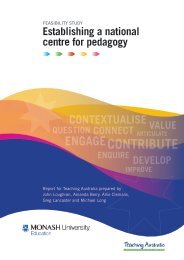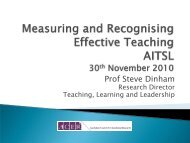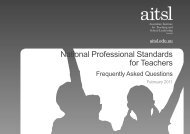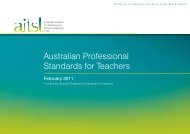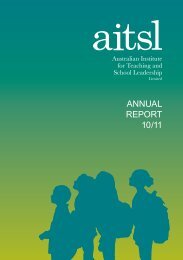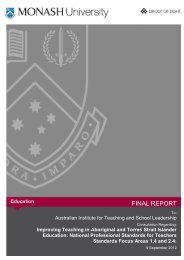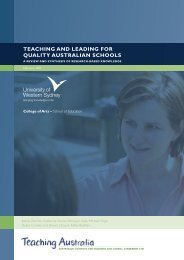Research on professional learningThe early history of professional learning (PL) reveals an emphasis on one-off exercises focused onspecific tasks related to teachers’ work, usually determined by system priorities. However, a broaderapproach is now recommended, recognising the range of ways in which teacher learning can takeplace. Little (2001) proposes four categories of ‘learning opportunities’ for teachers in the context ofreform agendas which point to the multidimensional ways in which professional learning can informpractice. They are: PL as inspiration and goal-setting to expand and enrich school practice; PL as thedevelopment of knowledge and skills related to ‘school-wide’ or government-identified priorities(typical of the early history mentioned above); PL as inquiry, which generates a problem-solvingapproach to practice; and PL as collaboration where teacher learning builds from within establishedprofessional communities.The potential of professional learningResearch and evaluation studies show clear evidence of the potentially valuable effects of PL on studentlearning. Yoon et al. (2007, p. iii) identify nine experimental studies of the effects of PL which met thestandards required by the US Institute for Education Sciences for such research, and found:... that average control group students would have increased their achievement by 21 percentilepoints if their teacher had received substantial professional development .... The effect size wasfairly consistent across the three content areas reviewed.In a large-scale statistical analysis of PL, Wallace (2009, p. 573) found:... moderate effects on teacher practice and very small but sometimes significant effects on studentachievement when the effects of professional development are mediated by teacher practice. Inspite of differences in samples, academic subjects, and assessments, the effects of professionaldevelopment on teacher practice and student achievement persist and are remarkably similaracross analyses.Like most educational research, findings of a positive effect on student learning are not universal. Forinstance, Garet et al. (2008), in an experimental study of a one year PL program on the teaching ofreading, found positive impacts on teacher knowledge and teaching methods but no significant effecton student learning, though this seems to raise more questions about the curriculum approach whichwas the subject of the PL than the PL itself. Nonetheless, it does suggest that a wide range of factorscan affect the potential impact of PL, and that PL is unlikely to succeed without careful considerationof them.Research into professional learning in recent times, both within and beyond PL for teachers, has beenvoluminous, and a strong consensus has developed about what forms of professional learning are mosteffective. From her review of PL across professions, and drawing on research in community and adulteducation, workplace learning, and professional undergraduate education, Webster-Wright (2009, p. 703)defines this consensus as recommending PL which is ‘continuing, active, social, and related to practice’.In research on PL for teachers, there is increasing evidence and agreement around a range ofapproaches, conditions and strategies (Bubb and Earley 2008; Colbert, Brown, Choi and Thomas 2008;Croft, Coggshall, Dolan, Powers and Killion 2010; Darling-Hammond, Wei, Andree, Richardson andOrphanos 2009; Doecke et al. 2008; Garet et al. 2008; Loucks-Horsley and Matsumoto 1999; Meiersand Ingvarson 2005; Mitchell and Cubey 2003; Penuel, Fishman, Yamaguchi and Gallagher 2007;Training and Development Agency 2007; Watson 2005; Yoon, Duncan, Lee, Scarloss and Shapley2007; Zaslow et al. 2010). These studies and recommendations confirm the relevance of principlesof adult learning (Beavers 2009; Brown 2006), as well as research on teachers’ learning processes(Meirink, Meijer, Verloop and Bergen 2009; Shank 2006). The results of these studies are combined inthe following summaries.9 <strong>Professional</strong> <strong>Learning</strong> <strong>Flagship</strong> <strong>Program</strong>: <strong>Leading</strong> <strong>Curriculum</strong> <strong>Change</strong>: Literature Review
Features of successful professional learning programsCombining the research studies cited above leads to the following broad conclusions about the features,strategies and conditions of successful PL. In terms of program features, successful PL programs will:• Respond to participants’ aspirations and understandings (including what one study called‘winning hearts and minds’)Connections to participants’ own felt needs are important to generate commitment to the PLgoals and process. This is sometimes achieved through performance management and careerdevelopment as well as self-evaluation and school improvement. Using data to identify problemsin school performance can be useful here. Research also suggests that participants in PL within aschool often take on leadership roles which can increase professional satisfaction. In their study ofteacher-driven, team-based PL, Colbert et al. (2008, p. 139) found that it ‘provides teachers withthe autonomy to define the objectives, establish professional networks, and identify and utilizestrategies that improve pedagogy and student learning’. An important implication here is the needto provide curriculum leaders with choice within PL.• Engage participants in collaborationOne of the strongest recent recommendations from research on PL is that it should involve thecollective participation of teachers from the same classrooms or schools in professional learning.McCormick et al., (2008, p. 6) observe that, ‘Collaboration ... is well supported by the evidence interms of its effectiveness and it can lead to a wide range of impacts. Collaboration is especiallyimportant to innovations in practice, as distinct from improving existing practice’. These ‘reformorientedprofessional development activities ... include being mentored or coached, participating ina committee or study group, or engaging in an internship’ (Penuel et al. 2007, p. 928).• Include investigations into their own settingsResearch recommends that participants analyse data from their own settings, since therevelation of discrepant data can motivate interest and revise understanding. This is an aspect ofdeveloping a learning-centred culture which is an important approach to PL (see the later sectionon professional learning communities). In their review of PL in the UK, McCormick et al. (2008,p. 6) have commented that, ‘Enquiry is seen to be important and there is strong evidence of itsimportance in ensuring changes in practice’. Scheerens (2010, p. 32) notes that ‘researchershave emphasised the notion of ongoing and lifelong professional learning embedded in schoolsas a natural and expected component of teachers’ professional activities and a key component ofschool improvement’. The goal should be that PL will ‘promote continuous enquiry and problemsolvingembedded in the daily life of schools’ (Training and Development Agency 2007, p. 3).• Engage participants in critical reflection and challenge assumptionsCritical reflection is a core aspect of successful PL when it enables participants to becomeaware of their own thinking, actions, and influences, to investigate and challenge assumptionsand to extend their thinking. Continuous assessment of their own practice is an important partof this. Loucks-Horsley (1999, p. 263) identifies the need to ‘Create cognitive dissonance todisturb existing beliefs’ and ‘Ensure that dissonance-creating and dissonance-resolving activitiesare connected to the teachers’ own students and context. It is widely accepted that changingeducational practice also requires changes to practitioners’ beliefs, understanding, and/or attitudes,and critical reflection is an important strategy for achieving this.• Establish clear shared understandings of purposeThe goals of the PL, and the reasons for them, must be clear, as should their ultimate connectionto educational outcomes. The UK Training and Development Agency (2007, p. 2) notes that PL iseffective if ‘it is planned with a clear vision of the effective or improved practice being sought’, and if‘this vision is shared by those undertaking the development and by people leading or supporting it’.<strong>Professional</strong> <strong>Learning</strong> <strong>Flagship</strong> <strong>Program</strong>: <strong>Leading</strong> <strong>Curriculum</strong> <strong>Change</strong>: Literature Review 10
- Page 1 and 2: Professional Learning FlagshipProgr
- Page 3 and 4: ContentsIntroduction ..............
- Page 5 and 6: Curriculum change: Implications for
- Page 7 and 8: Table 1: Overview of factors affect
- Page 9 and 10: This emphasis on capacity-building
- Page 11: Much of the foregoing discussion is
- Page 16 and 17: p. 1051) conclude that, ‘Findings
- Page 18 and 19: 2007; Gruenert 2005; Printy 2008; S
- Page 20 and 21: RecommendationsProfessional learnin
- Page 22 and 23: impersonal relationships• rationa
- Page 24 and 25: • The organisational goals are di
- Page 26 and 27: Table 2: Two views of teacher leade
- Page 28 and 29: A range of specifications and stand
- Page 30 and 31: In secondary schools, teacher leade
- Page 32 and 33: 1. Stimulus for innovation — Why
- Page 34 and 35: Table 4: Elements and processes of
- Page 36 and 37: The education of Indigenous student
- Page 38 and 39: ReferencesAinscow, M. (2005). Devel
- Page 40 and 41: Daly, A. J. (2009). Rigid Response
- Page 42 and 43: Hall, R. (1997). Knowledge Use and
- Page 44 and 45: Meirink, J., Meijer, P., Verloop, N
- Page 46 and 47: Thorpe, R., and Gold, J. (2010). Le
- Page 48: aitsl.edu.auFurther informationTele




